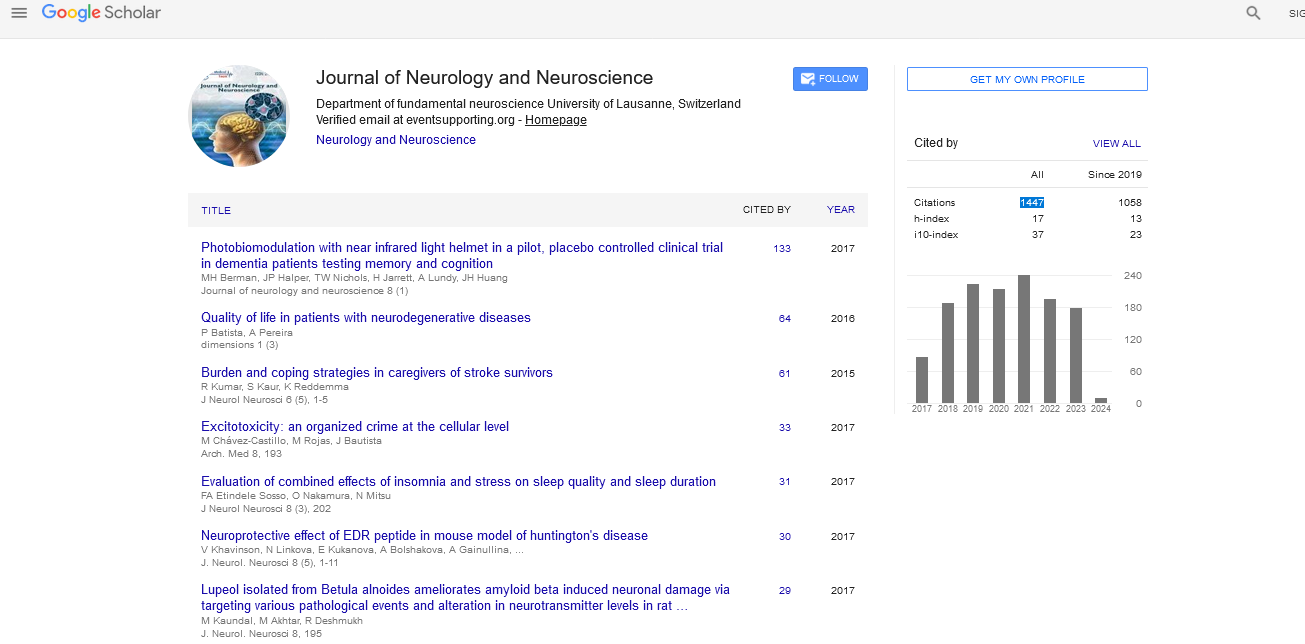Short Communication - (2025) Volume 16, Issue 3
The Role of High-Pressure Balloon Angioplasty in Treating Intracranial Atherosclerosis
Struel Mukamel*
Department of Neuroscience, Istanbul Medipol University, 34810 Istanbul, Turkey
*Correspondence:
Struel Mukamel, Department of Neuroscience, Istanbul Medipol University,
Turkey,
Email:
Received: 27-May-2025, Manuscript No. ipjnn-25-15711;
Editor assigned: 29-May-2025, Pre QC No. P-15711;
Reviewed: 12-Jun-2025, QC No. Q-15711;
Revised: 17-Jun-2025, Manuscript No. R-15711;
Published:
24-Jun-2025
Introduction
Intracranial Atherosclerotic Disease (ICAD) is a leading cause of ischemic stroke globally, with a particularly high prevalence in Asian, African, and Hispanic populations. It involves the progressive narrowing of major intracranial arteries, such as the Middle Cerebral Artery (MCA), basilar artery, and intracranial segments of the internal carotid and vertebral arteries, due to atherosclerotic plaque buildup. This narrowing can compromise cerebral perfusion and lead to Transient Ischemic Attacks (TIAs) or ischemic strokes through mechanisms such as artery-to-artery embolism or hemodynamic insufficiency. Despite advances in medical therapy including antiplatelet agents, statins, blood pressure control, and lifestyle modifications patients with severe stenosis (=70%) remain at a substantially elevated risk of recurrent stroke, particularly if they have already experienced an ischemic event. For this high-risk subgroup, endovascular interventions have been explored as potential alternatives or adjuncts to medical management [1].
Description
Among endovascular strategies, balloon angioplasty has emerged as a notable option. Unlike intracranial stenting, which introduces a permanent implant into a delicate vascular environment and carries a higher risk of complications such as in-stent restenosis, vessel perforation, or thromboembolic events, angioplasty aloneâ??particularly using high-pressure balloonsâ??offers a minimally invasive, implant-free approach to restoring blood flow. High-pressure balloon angioplasty refers to the use of balloons that can be inflated at pressures ranging from 8 to 20 atmospheres (atm) or more. These balloons are typically non-compliant or semi-compliant, meaning they retain their shape and diameter even under high pressures, providing controlled and precise dilation of the stenotic artery. The primary mechanism involves compressing or cracking the fibrotic or calcified atherosclerotic plaque while expanding the arterial lumen and improving distal perfusion [2].
The application of high-pressure balloons is particularly advantageous in treating resistant, rigid lesions that are less responsive to low-pressure dilation. These include lesions with dense calcification or those located in tortuous segments of the intracranial circulation where maneuverability is limited and stent deployment is technically challenging. The precision and strength of high-pressure balloons allow for adequate luminal gain while minimizing the risk of vessel dissection or rupture, especially when used with gradual inflation techniques and proper vessel sizing. Additionally, by avoiding stent implantation, the approach reduces the need for long-term dual antiplatelet therapy and eliminates risks associated with foreign body placement, such as delayed thrombosis or endothelial hyperplasia. In terms of clinical outcomes, several retrospective studies and case series have shown promising results with high-pressure balloon angioplasty for ICAD. For example, studies have reported technical success rates exceeding 90%, with short-term stroke or death rates generally lower than those observed with stenting. Importantly, patients selected for angioplasty are often those who have failed maximal medical therapy and continue to experience ischemic symptoms. For them, high-pressure angioplasty serves as a rescue therapy that may prevent further neurological deterioration. Moreover, angioplasty may be considered in specific anatomical contexts, such as lesions in the M1 segment of the MCA or the basilar artery, where stent placement may be riskier due to vessel tortuosity or branch involvement [3].
However, despite its benefits, high-pressure balloon angioplasty is not without risks. Potential complications include vessel dissection, perforation, abrupt vessel closure, and thromboembolic events. To mitigate these, careful patient selection is crucial. Ideal candidates are those with focal, concentric, and short-segment lesions, typically less than 10 mm in length, with good collateral circulation. Procedural precautions such as the use of road-mapping techniques, intraprocedural heparinization, and post-procedural monitoring are critical to improving safety. The learning curve for performing safe and effective angioplasty in intracranial vessels is steep, and operator experience significantly influences outcomes.
Another consideration is restenosis, which remains a potential limitation of angioplasty alone. While avoiding stents may reduce the rate of in-stent restenosis, the treated segment may still develop neointimal hyperplasia leading to re-narrowing. Some studies report restenosis rates of 20â??30% over a one-year follow-up period, though not all cases are symptomatic or require retreatment. In select cases, repeated angioplasty or even delayed stenting may be considered. Continued research is exploring the use of Drug-Coated Balloons (DCBs) in intracranial vessels, which release antiproliferative agents such as paclitaxel to reduce the risk of restenosisalthough this remains largely experimental and off-label at present [4].
In clinical practice, high-pressure balloon angioplasty is typically considered for patients who meet all the following criteria: symptomatic intracranial stenosis of = 70% confirmed by vascular imaging; failure of optimized medical therapy; evidence of perfusion deficit or hemodynamic compromise on imaging studies (e.g., perfusion MRI, CT perfusion, or SPECT); and lesions with favorable morphology (short, concentric, and non-ostial). The procedure is generally performed under general anesthesia or conscious sedation using biplane Digital Subtraction Angiography (DSA) guidance. After gaining femoral or radial access, a guide catheter is navigated to the target vessel, followed by a microcatheter over a microwire to cross the lesion. A high-pressure balloon catheter is then advanced and carefully inflated to the desired pressure for a controlled duration, followed by angiographic confirmation of vessel patency [5].
Conclusion
In the future, ongoing developments in imaging, device technology, and neurointerventional techniques are likely to refine the use of high-pressure balloon angioplasty further. The integration of advanced imaging techniques such as vessel wall MRI and Fractional Flow Reserve (FFR)-like measurements may help identify vulnerable plaques and stratify lesion severity more accurately. Meanwhile, newer balloon designs with better trackability, controlled compliance, and drug-eluting properties may improve both safety and efficacy. Additionally, clinical trials specifically comparing high-pressure angioplasty to optimized medical therapy or intracranial stenting are needed to establish evidence-based guidelines and inform patient selection criteria.
In conclusion, high-pressure balloon angioplasty plays a significant and evolving role in the treatment of symptomatic intracranial atherosclerosis, particularly in patients with severe stenosis who fail aggressive medical therapy. While not without risks, it offers a less invasive and potentially safer alternative to stenting when performed in appropriately selected patients. With careful technique, proper device selection, and ongoing research, high-pressure angioplasty may continue to serve as a valuable tool in the neurointerventional management of complex cerebrovascular disease.
Acknowledgment
None.
Conflict of Interest
None.
References
- Xiong Y, Zhou Z, Lin H, et al. The safety and long-term outcomes of angioplasty and stenting in symptomatic intracranial atherosclerotic stenosis. Int J Cardiol. 2015;179:23-24.
Google Scholar, Cross Ref, Indexed at
- Yamada T, Watanabe T, Sasaki Y. Plasticityâ??stability dynamics during post-training processing of learning. Trends Cogn Sci. 2024; 28(1):72-83.
Google Scholar, Cross Ref, Indexed at
- Fiorella D, Levy EI, Turk AS, et al. US multicenter experience with the wingspan stent system for the treatment of intracranial atheromatous disease: Periprocedural results. Stroke. 2007; 38(3):881-887.
Google Scholar, Cross Ref, Indexed at
- Xiao L, Wang J, Kassani PH, et al. Multi-hypergraph learning-based brain functional connectivity analysis in fMRI data. IEEE Trans Med Imaging. 2019; 39(5):1746-1758.
Google Scholar, Cross Ref, Indexed at
- Yamashita M, Shimokawa T, Peper F, et al. Functional network activity during errorless and trial-and-error color-name association learning. Brain and behavior. 2020; 10(8):e01723.
Google Scholar, Cross Ref, Indexed at





